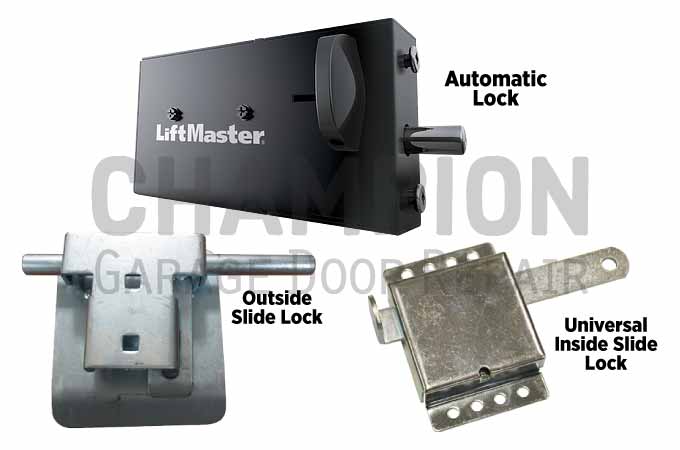Whether you have an existing garage door and want to improve security, or you’re a new garage owner looking for the best lock, this guide will help you choose an effective garage door lock for optimal security and functionality.
Garage door locks generally fall into two categories: automatic and manual. However, there are further details to consider when selecting the right lock. Below, we break down the types of locks, their features, and the types of doors they are best suited for.
External Manual Garage Door T-Lock
The T-lock is designed for manual garage doors without automatic openers. It features an external handle that twists to lock and unlock the door.
- How It Works: The handle connects to two horizontal wires, each linked to a latch on either side of the door that secures into a bracket. Twisting the handle retracts the wires and latches from the brackets, allowing the door to open. When closed, the handle automatically returns to its original position and locks the door.
- Security Feature: The handle can be locked or unlocked with a key, preventing it from twisting when locked.
- Best Use: Designed for sectional garage doors and cannot be used with single-piece garage doors (swing-up). Ideal for garages without a side door, where the garage door serves as the main entry. Not recommended for automated systems as it requires manual operation.
Internal Manual Garage Door Slide Lock
The internal slide lock is a traditional system designed to lock and secure the garage door from the inside.
- How It Works: The lock has a simple handle that slides into a slot on the door track, locking and securing the garage door in the closed position. To unlock, the handle is pulled out of the slot.
- Best Use: Works well for manual garage doors and can be used to improve security on automatic doors when you’re away. Ideal when you don’t need to lock and unlock your garage door from outside. Installing slide locks on both sides of the garage door provides a tighter lock and added security.
External Manual Garage Door Slide Lock
This lock allows you to lock and secure the garage door from outside.
- How It Works: The handle is mounted externally on the garage door and pushed into a hole drilled into the garage frame. It is then locked and secured with a padlock.
- Best Use: Commonly used with single-piece (swing-up) garage doors, but also adaptable for sectional garage doors.
Automatic Garage Door Lock
The automatic lock is a smart garage door deadbolt that locks and unlocks the door from inside the garage when you use the garage door opener.
- How It Works: The lock is hardwired to the motor and installed on the exterior of the door track. It secures the door by blocking the door rollers’ path with a cylinder. When opening the door, the cylinder retracts. It extends to lock the door when closed.
- Compatibility: Compatible with certain LiftMaster, Chamberlain, and Genie garage door openers, and designed for sectional garage doors. Generally used with side-mounted (wall-mounted) openers but can also be installed with ceiling-mounted models.
- Limitations: Only one lock per opener. If your garage lacks a side door or another way to get in, an automatic lock may not be ideal, as malfunctioning lock could lock you out of the garage.
Aftermarket Automatic Locks
There are also aftermarket smart deadbolts that can be used with a remote control or smartphone. While these locks aren’t typically designed for garage doors, they can be retrofitted to function similarly to the automatic garage door lock mentioned above.

However, since these locks usually don’t integrate with electric garage door openers, they are best suited for manual garage doors or as an additional layer of security.
As with the previous automatic lock type, you may want to avoid these smart locks if your garage doesn’t have another entryway besides the garage door, as a malfunction could potentially lock you out.
Garage Door Lock Button
If your garage door is electric, you may have noticed a button on your garage door wall control panel with a lock icon next to it. This feature, often called “vacation mode,” isn’t a physical lock, but activating it will disable remote devices, including handheld remotes, keypads, and cars programmed to the garage door opener.
If your wall control panel doesn’t have this feature, you can replace it with one that does. You may want to consult a licensed garage door repair company or your garage door manufacturer first to ensure compatibility with your existing overhead door system.
Manual vs. Automatic Lock
Manual locks are simple to install, more affordable, and durable. On the other hand, automatic locks are more complex to install, usually cost more, and tend to experience more issues. However, they offer greater convenience, as they eliminate the need for manual operation.
While it’s generally not recommended to use an automatic garage door lock when the garage door is the only entry to the garage, an electric garage door opener can serve as an effective alternative to a manual lock for locking and unlocking the door.
How to Lock Your Garage Door Without a Lock
To lock and secure your garage door from the inside, place a vise grip or screwdriver on the door track just above a roller. This will block the door’s path and hold it in place. For added security, repeat the process on both sides. This is a quick and effective way to lock your garage door from the inside if there’s an issue with your existing door lock or garage door opener.







